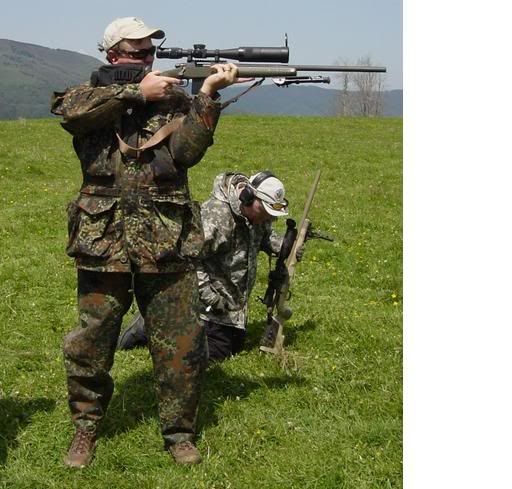Re: Try unsupported prone.
No offense but the reason these threads devolve is because, all Sterling does is regurgitate the same old thing.
He lists the elements of a steady position, as written. Period, there is nothing added to enlighten, there is just the constant beat of the same drum over and over again without any real instruction.
As Graham noted it is about his ego and his perception of the problem, although he fails to understand the elements involved in shooting from a bipod with a high powered scope as he admittedly so, avoids it for the more part. He dabbles in this type of shooting less than we shoot slings. Clearly.
While the fundamentals of Marksmanship are universal things have changed when you address different positions. An example of this:
Even with a bipod he advocates the use of a sling and the support hand up front on the forearm of the rifle. Well this can help solve a problem for someone, it is a not what constitutes a good position with a bipod. Straight back has been proven on many levels. A rear bag, or any rear support has been proven to enhance accuracy.
<span style="font-weight: bold">Of course like anything without proper instruction you can do it wrong. </span> That doesn't' dismiss the entire concept, just means people have filled in the missing blanks incorrectly.
This is where Sterling fails...
He doesn't have the ability to provide proper instruction in this case so he falls back to his talking points from which he never deviates. The 7 elements of a steady position are: 1, 2, 3, 4, 5, 6, & 7. End of conversation. Nothing on how to use them, or what they look or feel like, just constant repetition of the text.
Now they generally advocate the leg up position, but clearly the prone has been modified over the years to be a bit more effective and to manage the recoil.
Clearly this man is a big target, and has an acute angle at the shoulder, managing the recoil will be difficult at best. We want to eliminate angles, and be consistent.
The angles is the issue, at least we have learned but people continue to repeat what they see
So question: <span style="font-weight: bold">Why the leg up ? </span>
People ask this all the time, why the leg up, and the answer is usually to take the pressure of the diaphragm. Okay, but if we break at the bottom of breathing cycle you don't have to worry about breathing or your diaphragm correct ?
Now we have modified the prone again, slightly to be a bit straighter behind the rifle:
By being straight back and dropping square you can get a bit more consistent by indexing with the legs. Stepping up, dropping the knees and then falling straight down to form your support for the rifle.
This makes you a smaller target and allows for recoil management, where the other positions do not.
People will find a bit more discomfort at first, but with practice, and repetition like anything you can learn to use the position.
With a bipod it helps manage the recoil so the rifle barely moves.
Here with the bipod and a rear bag you can see how we have eliminated angles, as recoil will exploit the angles.
In high power, where you have lots of time, where rebuilding the position from shot to shot is not an issue, being at an angle is both comfortable and encouraged due to the ease of adoption. The pain threshold is very low, so people will pick up on faster.
But Sterling never talks about where the elbows are placed, (under the rifle) or how to set up the sling. What his tension feels like... so reads are tired of suffering his repeated calls for the use of this position and his constant text book responses that don't explain anything.
It's like constantly copying and pasting a link and telling people to go figure it out. Reading what you perceive as a problem and not being able to address, instead just repeating your same old mantra, well you see the results.
This is why it devolves, there is no "awareness" there is just repetition of text ignoring time, lessons learned and the slight differences in systems and positions. The details matter, ignoring them moves the conversation in the wrong direction.










